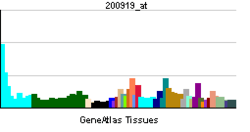PHC2
| Polyhomeotic homolog 2 (Drosophila) | |||||||||||||
|---|---|---|---|---|---|---|---|---|---|---|---|---|---|
| Identifiers | |||||||||||||
| Symbols | PHC2 ; EDR2; HPH2; PH2 | ||||||||||||
| External IDs | OMIM: 602979 MGI: 1860454 HomoloGene: 75090 GeneCards: PHC2 Gene | ||||||||||||
| |||||||||||||
| RNA expression pattern | |||||||||||||
 | |||||||||||||
| More reference expression data | |||||||||||||
| Orthologs | |||||||||||||
| Species | Human | Mouse | |||||||||||
| Entrez | 1912 | 54383 | |||||||||||
| Ensembl | ENSG00000134686 | ENSMUSG00000028796 | |||||||||||
| UniProt | Q8IXK0 | Q9QWH1 | |||||||||||
| RefSeq (mRNA) | NM_004427 | NM_001195083 | |||||||||||
| RefSeq (protein) | NP_004418 | NP_001182012 | |||||||||||
| Location (UCSC) | Chr 1: 33.79 – 33.9 Mb | Chr 4: 128.65 – 128.75 Mb | |||||||||||
| PubMed search | |||||||||||||
Polyhomeotic-like protein 2 is a protein that in humans is encoded by the PHC2 gene.[1][2][3]
In Drosophila melanogaster, the 'Polycomb' group (PcG) of genes are part of a cellular memory system that is responsible for the stable inheritance of gene activity. PcG proteins form a large multimeric, chromatin-associated protein complex. The protein encoded by this gene has homology to the Drosophila PcG protein 'polyhomeotic' (Ph) and is known to heterodimerize with EDR1 and colocalize with BMI1 in interphase nuclei of human cells. The specific function in human cells has not yet been determined. Two transcript variants encoding different isoforms have been found for this gene.[3]
Interactions
PHC2 has been shown to interact with MAPKAPK2,[4] PHC1,[1][5] BMI1[1] and MCRS1.[5]
References
- ↑ 1.0 1.1 1.2 Gunster MJ, Satijn DP, Hamer KM, den Blaauwen JL, de Bruijn D, Alkema MJ, van Lohuizen M, van Driel R, Otte AP (Apr 1997). "Identification and characterization of interactions between the vertebrate polycomb-group protein BMI1 and human homologs of polyhomeotic". Mol Cell Biol 17 (4): 2326–35. PMC 232081. PMID 9121482.
- ↑ Tonkin E, Hagan DM, Li W, Strachan T (Oct 2002). "Identification and characterisation of novel mammalian homologues of Drosophila polyhomeoticpermits new insights into relationships between members of the polyhomeotic family". Hum Genet 111 (4–5): 435–42. doi:10.1007/s00439-002-0814-3. PMID 12384788.
- ↑ 3.0 3.1 "Entrez Gene: PHC2 polyhomeotic homolog 2 (Drosophila)".
- ↑ Yannoni, Yvonne M; Gaestel Matthias; Lin Lih-Ling (Apr 2004). "P66(ShcA) interacts with MAPKAP kinase 2 and regulates its activity". FEBS Lett. (Netherlands) 564 (1–2): 205–11. doi:10.1016/S0014-5793(04)00351-5. ISSN 0014-5793. PMID 15094067.
- ↑ 5.0 5.1 Rual, Jean-François; Venkatesan Kavitha, Hao Tong, Hirozane-Kishikawa Tomoko, Dricot Amélie, Li Ning, Berriz Gabriel F, Gibbons Francis D, Dreze Matija, Ayivi-Guedehoussou Nono, Klitgord Niels, Simon Christophe, Boxem Mike, Milstein Stuart, Rosenberg Jennifer, Goldberg Debra S, Zhang Lan V, Wong Sharyl L, Franklin Giovanni, Li Siming, Albala Joanna S, Lim Janghoo, Fraughton Carlene, Llamosas Estelle, Cevik Sebiha, Bex Camille, Lamesch Philippe, Sikorski Robert S, Vandenhaute Jean, Zoghbi Huda Y, Smolyar Alex, Bosak Stephanie, Sequerra Reynaldo, Doucette-Stamm Lynn, Cusick Michael E, Hill David E, Roth Frederick P, Vidal Marc (Oct 2005). "Towards a proteome-scale map of the human protein-protein interaction network". Nature (England) 437 (7062): 1173–8. doi:10.1038/nature04209. PMID 16189514.
Further reading
- Satijn DP, Gunster MJ, van der Vlag J et al. (1997). "RING1 is associated with the polycomb group protein complex and acts as a transcriptional repressor". Mol. Cell. Biol. 17 (7): 4105–13. PMC 232264. PMID 9199346.
- Gunther M, Laithier M, Brison O (2000). "A set of proteins interacting with transcription factor Sp1 identified in a two-hybrid screening". Mol. Cell. Biochem. 210 (1–2): 131–42. doi:10.1023/A:1007177623283. PMID 10976766.
- Levine SS, Weiss A, Erdjument-Bromage H et al. (2002). "The core of the polycomb repressive complex is compositionally and functionally conserved in flies and humans". Mol. Cell. Biol. 22 (17): 6070–8. doi:10.1128/MCB.22.17.6070-6078.2002. PMC 134016. PMID 12167701.
- Strausberg RL, Feingold EA, Grouse LH et al. (2003). "Generation and initial analysis of more than 15,000 full-length human and mouse cDNA sequences". Proc. Natl. Acad. Sci. U.S.A. 99 (26): 16899–903. doi:10.1073/pnas.242603899. PMC 139241. PMID 12477932.
- Ota T, Suzuki Y, Nishikawa T et al. (2004). "Complete sequencing and characterization of 21,243 full-length human cDNAs". Nat. Genet. 36 (1): 40–5. doi:10.1038/ng1285. PMID 14702039.
- Yannoni YM, Gaestel M, Lin LL (2004). "P66(ShcA) interacts with MAPKAP kinase 2 and regulates its activity". FEBS Lett. 564 (1–2): 205–11. doi:10.1016/S0014-5793(04)00351-5. PMID 15094067.
- Beausoleil SA, Jedrychowski M, Schwartz D et al. (2004). "Large-scale characterization of HeLa cell nuclear phosphoproteins". Proc. Natl. Acad. Sci. U.S.A. 101 (33): 12130–5. doi:10.1073/pnas.0404720101. PMC 514446. PMID 15302935.
- Wang H, Wang L, Erdjument-Bromage H et al. (2004). "Role of histone H2A ubiquitination in Polycomb silencing". Nature 431 (7010): 873–8. doi:10.1038/nature02985. PMID 15386022.
- Gerhard DS, Wagner L, Feingold EA et al. (2004). "The status, quality, and expansion of the NIH full-length cDNA project: the Mammalian Gene Collection (MGC)". Genome Res. 14 (10B): 2121–7. doi:10.1101/gr.2596504. PMC 528928. PMID 15489334.
- Voncken JW, Niessen H, Neufeld B et al. (2005). "MAPKAP kinase 3pK phosphorylates and regulates chromatin association of the polycomb group protein Bmi1". J. Biol. Chem. 280 (7): 5178–87. doi:10.1074/jbc.M407155200. PMID 15563468.
- Stelzl U, Worm U, Lalowski M et al. (2005). "A human protein-protein interaction network: a resource for annotating the proteome". Cell 122 (6): 957–68. doi:10.1016/j.cell.2005.08.029. PMID 16169070.
- Rual JF, Venkatesan K, Hao T et al. (2005). "Towards a proteome-scale map of the human protein-protein interaction network". Nature 437 (7062): 1173–8. doi:10.1038/nature04209. PMID 16189514.
- Gregory SG, Barlow KF, McLay KE et al. (2006). "The DNA sequence and biological annotation of human chromosome 1". Nature 441 (7091): 315–21. doi:10.1038/nature04727. PMID 16710414.